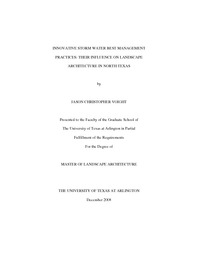
ATTENTION: The works hosted here are being migrated to a new repository that will consolidate resources, improve discoverability, and better show UTA's research impact on the global community. We will update authors as the migration progresses. Please see MavMatrix for more information.
Show simple item record
| dc.contributor.author | Voight, Jason Christopher | en_US |
| dc.date.accessioned | 2009-09-16T18:19:54Z | |
| dc.date.available | 2009-09-16T18:19:54Z | |
| dc.date.issued | 2009-09-16T18:19:54Z | |
| dc.date.submitted | January 2008 | en_US |
| dc.identifier.other | DISS-10046 | en_US |
| dc.identifier.uri | http://hdl.handle.net/10106/1797 | |
| dc.description.abstract | The land development process is essentially a three step progression consisting of input from developers who envision and fund a project, designers who translate the developer's vision into a buildable project, and the regulators who ensure that the project upholds, to the extent allowable by law, the health, safety, and welfare of mankind including the environment.As an outgrowth of this development model, the modern American city has evolved overtime into a sprawling metropolis, which has had a direct, deleterious impact on watersheds. To address these detrimental impacts, storm water regulations have been authored on federal, state, and local levels, which include the use of low impact development techniques, integrated storm water management techniques, and structural (or built) storm water best management practices to reduce water quantity and improve water quality. However, a majority of these storm water management techniques are used for strictly utilitarian purposes. The metropolitan area collectively referred to as North Central Texas represents this model.The objective of this research is to identify the selection preferences of integrated storm water management techniques for developing or re-developing areas by the representatives of the development process. Although the technology is available, integrated storm water management techniques for aesthetic, environmental, or educational purposes are seldom implemented in developments and redevelopments in North Central Texas. The evidence, obtained through qualitative analysis of responses from the aforementioned representatives, suggests that selection preferences are based on cost/expense, appropriateness, and existing experience or ignorance towards another equitable solution. | en_US |
| dc.description.sponsorship | Taylor, Pat D. | en_US |
| dc.language.iso | EN | en_US |
| dc.publisher | Landscape Architecture | en_US |
| dc.title | Innovative storm water best management practices : their influence on landscape architecture in North Texas | en_US |
| dc.type | M.L.A. | en_US |
| dc.contributor.committeeChair | Taylor, Pat D. | en_US |
| dc.degree.department | Landscape Architecture | en_US |
| dc.degree.discipline | Landscape Architecture | en_US |
| dc.degree.grantor | University of Texas at Arlington | en_US |
| dc.degree.level | masters | en_US |
| dc.degree.name | M.L.A. | en_US |
| dc.identifier.externalLink | http://www.uta.edu/ra/real/editprofile.php?onlyview=1&pid=1152 | |
| dc.identifier.externalLinkDescription | Link to Research Profiles | |
Files in this item
- Name:
- Voight_uta_2502M_10046.pdf
- Size:
- 13.27Mb
- Format:
- PDF
- Name:
- Voight_uta_2502M_10046.pdf
- Size:
- 13.27Mb
- Format:
- PDF
This item appears in the following Collection(s)
Show simple item record


